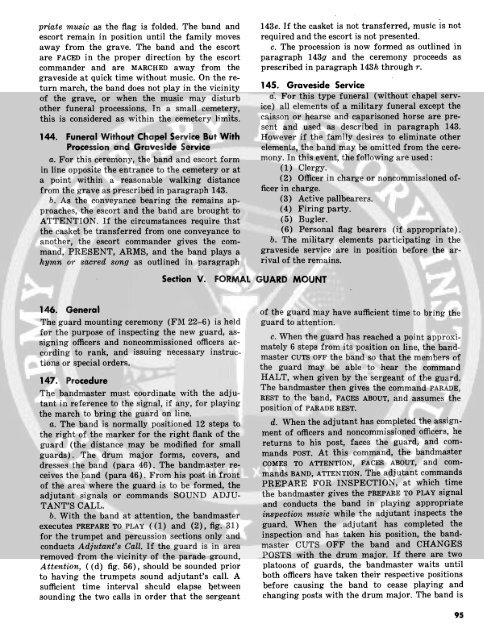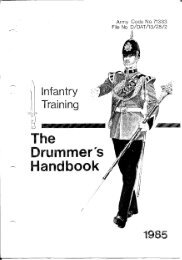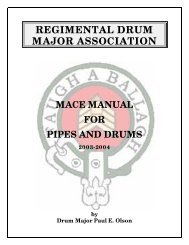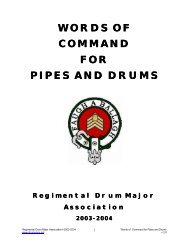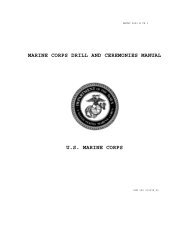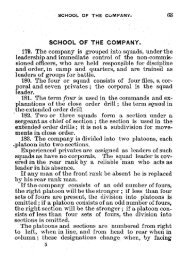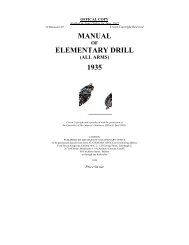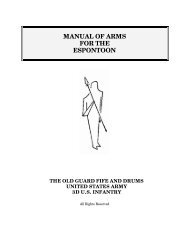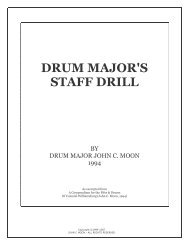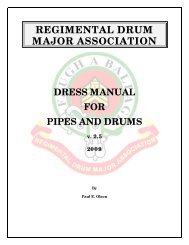The Military Band - Regimental Drum Major Association
The Military Band - Regimental Drum Major Association
The Military Band - Regimental Drum Major Association
You also want an ePaper? Increase the reach of your titles
YUMPU automatically turns print PDFs into web optimized ePapers that Google loves.
priate music as the flag is folded. <strong>The</strong> band and 143e. If the casket is not transferred, music is not<br />
escort remain in position until the family moves required and the escort is not presented.<br />
away from the grave. <strong>The</strong> band and the escort c. <strong>The</strong> procession is now formed as outlined in<br />
are FACED in the proper direction by the escort paragraph 143g and the ceremony proceeds as<br />
commander and are MARCHED away from the prescribed in paragraph 143h through r.<br />
graveside at quick time without music. On the return<br />
march, the band does not play in the vicinity 145. Graveside Service<br />
of the grave, or when the music may disturb a. For this type funeral (without chapel servother<br />
funeral processions. In a small cemetery, ice) all elements of a military funeral except the<br />
this is considered as within the cemetery limits. caisson or hearse and caparisoned horse are present<br />
and used as described in paragraph 143.<br />
144. Funeral Without Chapel Service But With However if the family desires to eliminate other<br />
Procession and Graveside Service elements, the band may be omitted from the cerea.<br />
For this ceremony, the band and escort form mony. In this event, the following are used:<br />
in line opposite the entrance to the cemetery or at (1) Clergy.<br />
a point within a reasonable walking distance (2) Officer in charge or noncommissioned offrom<br />
the grave as prescribed in paragraph 143. ficer in charge.<br />
b. As the conveyance bearing the remains ap- (3) Active pallbearers.<br />
proaches, the escort and the band are brought to (4) Firing party.<br />
ATTENTION. If the circumstances require that (5) Bugler.<br />
the casket be transferred from one conveyance to (6) Personal flag bearers (if appropriate).<br />
another, the escort commander gives the com- b. <strong>The</strong> military elements participating in the<br />
mand, PRESENT, ARMS, and the band plays a graveside service are in position before the arhymn<br />
or sacred song as outlined in paragraph rival of the remains.<br />
Section V. FORMAL GUARD MOUNT<br />
146. General of the guard may have sufficient time to bring the<br />
<strong>The</strong> guard mounting ceremony (FM 22-6) is held guard to attention.<br />
for the purpose of inspecting the new guard, assigningsigning<br />
officers<br />
officers<br />
and<br />
and<br />
noncommissioned<br />
noncommissioned<br />
officers<br />
officers<br />
acaccording<br />
to rank, and issuing necessary instrucc.<br />
When the guard has reached a point approxi-<br />
mately 6 steps from its position on line, the band-<br />
master CUTS OFF the band so that the members of<br />
tions or special orders.<br />
master CUTS OFF the band so that the members of<br />
the guard may be able to hear the command<br />
147. Procedure HALT, when given by the sergeant of the guard.<br />
<strong>The</strong> bandmaster then gives the command PARADE,<br />
<strong>The</strong> bandmaster must coordinate with the adju- <strong>The</strong> bandmaster then gives the command PARADE,<br />
tant in reference to the signal, if any, for playing REST to the band, FACES ABOUT, and assumes the<br />
the march to bring the guard on line.<br />
a. <strong>The</strong> band is normally positioned 12 steps to d. When the adjutant has completed the assignthe<br />
right of the marker for the right flank of the ment of officers and noncommissioned officers, he<br />
guard (the distance may be modified for small returns to his post, faces the guard, and comguards).<br />
<strong>The</strong> drum major forms, covers, and mands POST. At this command, the bandmaster<br />
dresses the band (para 46). <strong>The</strong> bandmaster re- COMES TO ATTENTION, FACES ABOUT, and comceives<br />
the band (para 46). From his post in front mands BAND, ATTENTION. <strong>The</strong> adjutant commands<br />
of the area where the guard is to be formed, the PREPARE FOR INSPECTION, at which time<br />
adjutant signals or commands SOUND ADJU- the bandmaster gives the PREPARE TO PLAY signal<br />
TANT'S CALL. and conducts the band in playing appropriate<br />
b. With the band at attention, the bandmaster inspection music while the adjutant inspects the<br />
executes PREPARE TO PLAY ((1) and (2), fig. 31) guard. When the adjutant has completed the<br />
for the trumpet and percussion sections only and inspection and has taken his position, the bandconducts<br />
Adjutant's Call. If the guard is in area master CUTS OFF the band and CHANGES<br />
removed from the vicinity of the parade ground, POSTS with the drum major. If there are two<br />
Attention, ((d) fig. 56), should be sounded prior platoons of guards, the bandmaster waits until<br />
to having the trumpets sound adjutant's call. A both officers have taken their respective positions<br />
sufficient time interval should elapse between before causing the band to cease playing and<br />
sounding the two calls in order that the sergeant changing posts with the drum major. <strong>The</strong> band is<br />
95


